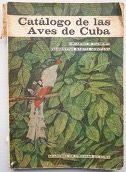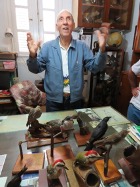No, not all of them, just the one for Cuba. It’s number 26 and I strongly advise you to buy it (the printed version, in English), although I may be biased, being one of the authors.
Way back last century, in 1975, two of Cuba’s most distinguished ornithologists (and naturalists) wrote a Catálogo de las Aves de Cuba. I don’t think I really need to translate that. Although it was written in Spanish, all the species had their English names given, both with the species account and in the index. As you can see, my copy is now somewhat dog-eared.

Catálogo de las Aves de Cuba
Fast forward to the 1990s and the surviving author of that book, Orlando Garrido, thought that it was time to update it. He set about doing just that with his protégé, Arturo Kirkconnel, who was a colleague at the Museo de Historia Natural in Havana (I don’t need to translate that, either!). Again, they wrote in Spanish but came up against problems in getting it published. To cut the story short, by the beginning of the 21st century, they had decided to publish it in English and enlisted the help of the USA’s late Jim Wiley and the UK’s Guy Kirwan. Things progressed slowly, not least because of the communication problems with Cuba. I joined the team later, in the 2010s. The project was then further stalled when Jim Wiley became seriously ill and subsequently died in September 2018.
But we finished it, and of course dedicated it to Jim. Garrido was a ranked tennis player in his youth1. and is still in fine health, as you can see from this photo of him at his home in Havana, having just turned 91 years old.

Photo: Susan Jacobson
We sat back with a sigh of relief after so many years work. After the BOC publication appeared, the authors got our allocation of free copies and decided who should receive one – some Cuban institutions and some Cuban individuals who had helped us – and at that point it became clear that very few Cubans would ever get to read it. This gnawed away at me. Our aim in writing the book was clearly stated in the Preface; “to provide an accurate baseline account of Cuban birds. We trust [it] will further incentivise bird conservation efforts in Cuba and promote a desire for involvement amongst upcoming young Cuban ornithologists.” How could it do that if it was inaccessible and far too expensive for all but Cuban institutions?
It was then that I decided that it should be made readily available to everyone in Cuba who was interested. Luckily, the BOC agreed with me and I set about translating the book into Spanish and, more importantly, considering how to make it freely (and cheaply) available in Cuba. It turned out that the “freely and cheaply” part was the easiest! I did eventually get the book translated, although not all of it. I decided that the (extensive) chapters on Zoology, Geology and Geography, and Vegetation and Habitats were far too much for me – and anyway, most that information was already available in Cuba in books produced there.
I ended up with a translation of all the birdy parts of the book, but I knew it wasn’t that good. I also knew that it wasn’t really in Cuban Spanish and I needed help. Luckily my good friend and tour guide extraordinaire, Nathaly O’Farrill, was happy to help and provided an enormous number of improvements. Then Arturo Kirkconnell found time away from updating his Field Guide to the Birds of Cuba to check and improve much of the technical stuff especially.
So here it is, a PDF of a book called Las Aves de Cuba for the people of Cuba. It’s their country, and their birds and it’s right that they should have the book in their language. I hope this becomes the norm for the series.
Author information
Andy Mitchell. A sort-of retired, sort-of ornithologist, sort-of tour guide, living in Orkney.
- Orlando Garrido reached the fourth round of the Wimbledon mixed doubles in 1956. He also played there in the men’s singles from 1956-1961, but was knocked out in the first round each time. He lost to Britain’s Roger Taylor in 1961 and I remember watching the match!

